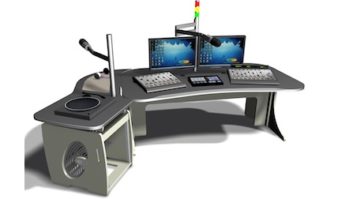You probably missed the anniversary last year; I know I nearly did. If you’d known, you could have sent a card, or had a little party to commemorate the event. Best of all, you could have created a PowerPoint presentation … in honor of the 20th anniversary of PowerPoint.
It seems hard to believe, but yes, there was a time before PowerPoint — a time when “slides” were actually, well, slides — little pictures on pieces of polyester film.
Back in those Neanderthal times, anything more elaborate than an overhead transparency needed a graphic artist’s talents for typography and design, followed by a visit to the Forox camera operator and his pin-registered rig. A dip in the soup, then off to the glass mounts; it took a small village to get a slide show together.

PDP-11 minicomputers were harnessed early on to try their virtual hands at graphical tasks, but the resulting GE Genigraphics system did little to liberate the presenting public, as it required a $300,000 workstation, skilled operators for slide creation and a service bureau for imaging the results. With the advent of personal computing, though, it wasn’t long before a bright fellow — one Robert Gaskins, to be precise — found a way to harness the microprocessor and empower individuals to create their own presentation materials.
Show business obsession
Gaskins had no idea of the trouble he’d caused. Writing in a past issue of Communications of the ACM, he ruefully noted the wild abandon with which normally staid presenters began to dress up their slides.
“With no constrains from physical media,” he wrote, “presenters had no limitation and increasingly no firm intuition as to what was appropriate.”
This disinhibition effect has remained a hallmark of the PowerPoint experience. Colorful templates and royalty-free clip art collections have, in Gaskins’ eyes, blunted the impact of factual content by making it seem like promotional fluff.
In our experience, a few perceptive presenters have been careful to note this boundary; one prominent medical researcher told us, long ago, that his slides needed to be either white-on-black or black-on-white. Anything flashier would clearly signal to the audience that he was in the pocket of Big Pharma. He was, arguably, the last of his breed.
What’s more, few stop to think about the amount of employee effort lost in the compulsive pursuit of animated bullet points and Venetian blind wipes, energy which presumably could have been used to add revenue to the corporation’s bottom line.
One CEO who did, in fact, notice this problem was Sun Microsystems’ founder and president, Scott McNealy. In a now-legendary speech, McNealy recalled seeing that a substantial percentage of Sun’s disk storage space was taken up by his workers’ PowerPoint creations.
“It freaks me out just to think about it,” McNealy said. “Do you know how many person-centuries that is? Of clip-art manipulations? I banned PowerPoint from our company.”
In the wrong hands, McNealy felt, PowerPoint could become less a “personal productivity tool” than a non-productive “activity generator.”
All-purpose solution
Twenty years later, on a purely practical level, the medium has become more than the message; it has become a platform, a transport method for images which need not have been composed and created within PowerPoint.
For instance, I’ve pointed more than a few local nonprofits toward PowerPoint as a down-market solution for their digital signage needs: It’s inexpensive, compared to virtually any digital signage software package; it will run unattended, employing automated timings, moving graphical elements and even multimedia elements; and, best of all, it’s familiar — easily programmed by anyone who’s been exposed to Microsoft products. Today, you’ll find digital signage delivered via the PowerPoint platform in schools, church lobbies and exhibit kiosks.
The ubiquity and accessibility of PowerPoint have given it a host of other uses as well.
I routinely receive faux-storyboards from corporate clients done up in the familiar “handout” layout; and we often use a fully-composed slide set as the basis for creating more suitable television graphics, especially for complex medical topics. Most curious of all, we occasionally receive e-mails with multiple PowerPoint presentations attached — each containing a single still picture. Seems that for many people, PowerPoint is the one wrapper which springs to mind when it comes to transporting digital images.
Out of control
There are some who feel that cognition ends when the PowerPoint cheesecake begins.
Gaskins, for one, believes that clearer, more restrained visuals deliver better impact. “Most contemporary presentations should return to formats nearly as spare as the old overhead transparencies,” he wrote.
That’s the reasoned voice of an engineer, researcher and computer scientist speaking; to an organized mind, excessive decoration is clearly pointless, wasteful and potentially harmful to the message.
Gaskins isn’t alone. There are plenty of us out there banging the drum for clearer, more easily understood visuals. Still, the man who dreamed of giving graphical power to the masses may still, alas, be dreaming — especially when he says, “The only solution is for presenters to develop a better sense of what is appropriate.” Good luck with that.
Walter Schoenknecht is a contributor to TV Technology, a sister publication to Radio World. He is a partner at Midnight Media Group Inc., a New York-area digital production facility. Reach him via e-mail at [email protected].











